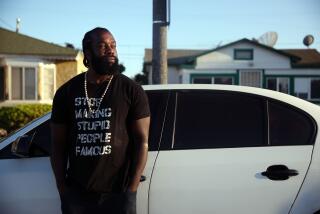Police-Stop Data Suggest Imbalance
SAN DIEGO — In the first study of its kind by a big-city police agency, the San Diego Police Department released preliminary results Thursday suggesting that blacks and Latinos are more likely to be stopped and searched by officers than whites or Asian Americans.
“This is no surprise to us; we live this reality every day,” said Sydney Ethridge, president of San Diego’s Coalition of African-American Organizations.
Backed by Ethridge, several other African American community leaders and executives of the local chapter of the American Civil Liberties Union, Police Chief David Bejarano promised further analysis to see if his officers are stopping drivers solely because of their skin color.
“There are a lot of questions we need to answer,” Bejarano said. “If there are problems, we want to make sure we address them with training, supervision and, if necessary, discipline.”
Bejarano, however, said that nothing he has seen so far makes him believe San Diego officers are acting improperly.
In a video shown to the department’s 2,100 officers during roll call, Bejarano said they should not view the preliminary results as reflecting negatively on their work, which he praised.
At a news conference outside police headquarters, he promised six more months of study, including review of the traffic-stop numbers and interviews with officers and community members.
Bejarano, the city’s first Latino chief, ordered the $100,000 study last year after complaints that officers stop blacks and Latinos for no reason or for minor infractions that would be overlooked if committed by a white or Asian American.
Based on records collected by officers for 91,552 traffic stops in the first six months of this year, researchers hired by the department found that the chance of being stopped during the study period was 8% for whites and Asians and 14% for blacks and Latinos. The chances were derived by comparing the ethnic breakdown of the traffic stops with the numbers of driving-age people in each category.
The study showed that while blacks are 8% of the driving-age population, they account for 12% of traffic stops and 20% of those searched. Latinos, with 20% of the driving-age population, accounted for 29% of the stops and 50% of the searches.
The politically volatile issue of alleged racial profiling by police has flared across the country in the last year.
At the urging of U.S. Atty. Gen. Janet Reno, dozens of police departments across the country are gathering ethnic statistics on people who are stopped and searched. But some law enforcement leaders have refused to ask their officers to gather such data, notably Los Angeles Police Chief Bernard C. Parks and Los Angeles County Sheriff Lee Baca.
Gov. Gray Davis last year vetoed a bill by state Sen. Kevin Murray (D-Culver City) that would have required law enforcement agencies to keep ethnic data on traffic stops. A similar requirement was withdrawn this session, but the governor did sign a Murray bill requiring that police officers in California receive expanded diversity training.
Davis said decisions about gathering ethnic statistics are best left to the local agencies, but he ordered the California Highway Patrol to examine its traffic stops for any signs of racial profiling.
Although some police labor unions have resisted such studies and vowed that their members would not cooperate, the San Diego Police Officers Assn. backed the study idea. During six months, officers recorded ethnic information on drivers they stopped.
“This department has nothing to hide,” said association President Bill Farrar, a San Diego officer for 28 years. “If there is a problem, or the perception of a problem, let’s deal with it openly.”
Bejarano said he was not surprised by the findings, noting that they seemed to match those in a limited study done last year by the San Jose Police Department. And he stressed that numbers alone cannot determine whether San Diego officers are acting improperly.
He added that the study might be skewed by using a low number for the percentage of Latino drivers.
The researchers--from Vanderbilt University, San Diego State University and Eastern Kentucky University--chose to use the 1990 U.S. census for the number of driving-age people living in San Diego.
But the census has been criticized in the past for undercounting minorities. Also, as a border city, San Diego has a large number of drivers from Mexico, Bejarano noted.
From the beginning of the study, the chief included a cross-section of community leaders, even some who have been critical of the Police Department in the past, particularly over police use of lethal force.
Release of the preliminary results was delayed so Bejarano could provide private briefings to those leaders. In the short run, at least, the strategy seems to have defused a potentially divisive issue.
Some of Bejarano’s strongest critics in the past attended a news conference with him outside police headquarters.
“San Diego has to be commended for taking the leadership role” in the racial-profiling debate, said John Johnson, president of the local Urban League chapter. “That’s important to me and people who look like me.”
Jordan Budd, managing attorney of the local ACLU chapter, praised Bejarano for beginning a study that will “get beneath the perceptions and into the reality of what is happening on the streets.”
More to Read
Sign up for Essential California
The most important California stories and recommendations in your inbox every morning.
You may occasionally receive promotional content from the Los Angeles Times.










